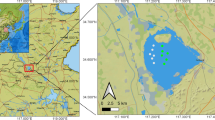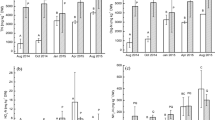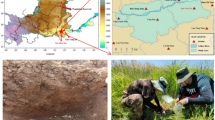Abstract
Submerged macrophytes play an important role in aquatic ecosystems, which has led to an increase in studies on vegetation recovery in polluted lakes from which submerged macrophytes have disappeared. The comparison of microbial communities in sediment cloned with planted and naturally growing submerged macrophytes is an interesting but rarely studied topic. In this investigation, Maojiabu and Xilihu, two adjacent sublakes of West Lake (Hangzhou, China), were selected as aquatic areas with planted and naturally growing macrophytes, respectively. Sediment samples from sites with/without Vallisneria natans were collected from both sublakes. The results showed that sediment total nitrogen and organic matter were significantly lower in the plant-covered sites than that in the non-plant sites in Maojiabu. Additionally, the sediment microbial community characterized by 16S ribosomal RNA (rRNA) sequencing differed more significantly for Maojiabu than for Xilihu. The relative abundances of microbes involved in C, N, and S elemental cycling were significantly higher in the sediments with plants than in those without. Results from both fatty acid methyl ester analysis and 16S rRNA sequencing indicated that vegetation significantly influenced the sulfate-reducing bacteria (SRB). Thus, the gene copies and composition of SRB were explored further. The relative gene abundance of SRB was 66% higher with natural vegetation colonization but was not influenced by artificial colonization. An increase in dominant SRB members from the families Syntrophobacteraceae and Thermodesulfovibrionaceae contributed to the increase of total SRB. Thus, macrophyte planting influences sediment nutrient levels and microbial community more than natural growth does, whereas the latter is more beneficial to sediment SRB.




Similar content being viewed by others
References
Rodrigo MA, Rojo C, Alonso-Guillen JL, Vera P (2013) Restoration of two small Mediterranean lagoons: the dynamics of submerged macrophytes and factors that affect the success of revegetation. Ecol. Eng. 54:1–15. doi:10.1016/j.ecoleng.2013.01.022
Sondergaard M, Johansson LS, Lauridsen TL, Jorgensen TB, Liboriussen L, Jeppesen E (2010) Submerged macrophytes as indicators of the ecological quality of lakes. Freshw. Biol. 55(4):893–908. doi:10.1111/j.1365-2427.2009.02331.x
Scheffer M, Carpenter S, Foley JA, Folke C, Walker B (2001) Catastrophic shifts in ecosystems. Nature 413(6856):591–596. doi:10.1038/35098000
Sand-Jensen K, Pedersen NL, Thorsgaard I, Moeslund B, Borum J, Brodersen KP (2008) 100 years of vegetation decline and recovery in Lake Fure, Denmark. J. Ecol. 96(2):260–271. doi:10.1111/j.1365-2745.2007.01339.x
Hilt S, Van de Weyer K, Koehler A, Chorus I (2010) Submerged macrophyte responses to reduced phosphorus concentrations in two peri-urban lakes. Restor. Ecol. 18:452–461. doi:10.1111/j.1526-100X.2009.00577.x
Korner S (2002) Loss of submerged macrophytes in shallow lakes in north-eastern Germany. Int. Rev. Hydrobiol. 87(4):375–384. doi:10.1002/1522-2632(200207)87:4<375::aid-iroh375>3.0.co;2-7
Lauridsen TL, Jensen JP, Jeppesen E, Sondergaard M (2003) Response of submerged macrophytes in Danish lakes to nutrient loading reductions and biomanipulation. Hydrobiologia 506(1–3):641–649. doi:10.1023/b:hydr.0000008633.17385.70
Hilt S, Gross EM, Hupfer M, Morscheid H, Mahlmann J, Melzer A, Poltz J, Sandrock S, Scharf EM, Schneider S, de Weyer KV (2006) Restoration of submerged vegetation in shallow eutrophic lakes—a guideline and state of the art in Germany. Limnologica 36(3):155–171. doi:10.1016/j.limno.2006.06.001
Sondergaard M, Jeppesen E, Lauridsen TL, Skov C, Van Nes EH, Roijackers R, Lammens E, Portielje R (2007) Lake restoration: successes, failures and long-term effects. J. Appl. Ecol. 44(6):1095–1105. doi:10.1111/j.1365-2664.2007.01363.x
Chen K-N, Bao C-H, Zhou W-P (2009) Ecological restoration in eutrophic Lake Wuli: a large enclosure experiment. Ecol. Eng. 35(11):1646–1655. doi:10.1016/j.ecoleng.2008.10.009
Gulati RD, Pires LMD, Van Donk E (2008) Lake restoration studies: failures, bottlenecks and prospects of new ecotechnological measures. Limnologica 38(3–4):233–247. doi:10.1016/j.limno.2008.05.008
Liao CZ, Luo YQ, Fang CM, Chen JK, Li B (2012) The effects of plantation practice on soil properties based on the comparison between natural and planted forests: a meta-analysis. Glob. Ecol. Biogeogr. 21(3):318–327. doi:10.1111/j.1466-8238.2011.00690.x
Vitali F, Mastromei G, Senatore G, Caroppo C, Casalone E (2016) Long lasting effects of the conversion from natural forest to poplar plantation on soil microbial communities. Microbiol. Res. 182:89–98. doi:10.1016/j.micres.2015.10.002
Lin YT, Hu HW, Whitman WB, Coleman DC, Chiu CY (2014) Comparison of soil bacterial communities in a natural hardwood forest and coniferous plantations in perhumid subtropical low mountains. Bot. Stud. 55:9. doi:10.1186/s40529-014-0050-x
Heilmayr R (2014) Conservation through intensification? The effects of plantations on natural forests. Ecol. Econ. 105:204–210. doi:10.1016/j.ecolecon.2014.06.008
Espinar JL (2006) Sample size and the detection of a hump-shaped relationship between biomass and species richness in Mediterranean wetlands. J. Veg. Sci. 17(2):227–232. doi:10.1111/j.1654-1103.2006.tb02441.x
Costantini ML, Rossi L, Fazi S, Rossi D (2009) Detritus accumulation and decomposition in a coastal lake (Acquatina-southern Italy). Aquat. Conserv. 19(5):566–574. doi:10.1002/aqc.1004
Cornwell JC, Owens MS (2011) Quantifying sediment nitrogen releases associated with estuarine dredging. Aquat. Geochem. 17(4–5):499–517. doi:10.1007/s10498-011-9139-y
Li H, Song CL, Cao XY, Zhou YY (2016) The phosphorus release pathways and their mechanisms driven by organic carbon and nitrogen in sediments of eutrophic shallow lakes. Sci. Total Environ. 572:280–288. doi:10.1016/j.scitotenv.2016.07.221
Obi CC, Adebusoye SA, Ugoji EO, Ilori MO, Amund OO, Hickey WJ (2016) Microbial communities in sediments of Lagos lagoon, Nigeria: elucidation of community structure and potential impacts of contamination by municipal and industrial wastes. Front. Microbiol. 7:16. doi:10.3389/fmicb.2016.01213
Schutter ME, Dick RP (2000) Comparison of fatty acid methyl ester (FAME) methods for characterizing microbial communities. Soil Sci. Soc. Am. J. 64(5):1659–1668
Geets J, Borrernans B, Diels L, Springael D, Vangronsveld J, van der Lelie D, Vanbroekhoven K (2006) DsrB gene-based DGGE for community and diversity surveys of sulfate-reducing bacteria. J. Microbiol. Methods 66(2):194–205. doi:10.1016/j.mimet.2005.11.002
Chaparro JM, Badri DV, Vivanco JM (2014) Rhizosphere microbiome assemblage is affected by plant development. ISME J 8(4):790–803. doi:10.1038/ismej.2013.196
Leon JD, Gonzalez MI, Gallardo JF (2011) Biogeochemical cycles in natural forest and conifer plantations in the high mountains of Colombia. Rev. Biol. Trop. 59(4):1883–1894
Yang K, Zhu JJ, Zhang M, Yan QL, Sun OJ (2010) Soil microbial biomass carbon and nitrogen in forest ecosystems of Northeast China: a comparison between natural secondary forest and larch plantation. J. Plant Ecol. 3(3):175–182. doi:10.1093/jpe/rtq022
da Silva DKA, Freitas ND, de Souza RG, da Silva FSB, de Araujo ASF, Maia LC (2012) Soil microbial biomass and activity under natural and regenerated forests and conventional sugarcane plantations in Brazil. Geoderma 189:257–261. doi:10.1016/j.geoderma.2012.06.014
Song K, Harper WF, Hori T, Riya S, Hosomi M, Terada A (2015) Impact of carbon sources on nitrous oxide emission and microbial community structure in an anoxic/oxic activated sludge system. Clean Techn. Environ. Policy 17(8):2375–2385. doi:10.1007/s10098-015-0979-9
Kindaichi T, Yuri S, Ozaki N, Ohashi A (2012) Ecophysiological role and function of uncultured Chloroflexi in an anammox reactor. Water Sci. Technol. 66(12):2556–2561. doi:10.2166/wst.2012.479
Simek K, Nedoma J, Znachor P, Kasalicky V, Jezbera J, Hornak K, Sed’a J (2014) A finely tuned symphony of factors modulates the microbial food web of a freshwater reservoir in spring. Limnol. Oceanogr. 59(5):1477–1492. doi:10.4319/lo.2014.59.5.1477
Wang Z, Yang YY, Sun WM, Xie SG, Liu Y (2014) Nonylphenol biodegradation in river sediment and associated shifts in community structures of bacteria and ammonia-oxidizing microorganisms. Ecotox Environ Safe 106:1–5. doi:10.1016/j.ecoenv.2014.04.019
Liang SH, Liu JK, Lee KH, Kuo YC, Kao CM (2011) Use of specific gene analysis to assess the effectiveness of surfactant-enhanced trichloroethylene cometabolism. J. Hazard. Mater. 198:323–330. doi:10.1016/j.jhazmat.2011.10.050
Holmer M, Storkholm P (2001) Sulphate reduction and sulphur cycling in lake sediments: a review. Freshw. Biol. 46(4):431–451. doi:10.1046/j.1365-2427.2001.00687.x
Zhang W, Zhang L (2016) Vertical and temporal distributions of sulfate-reducing bacteria in sediments of Lake Erhai, Yunnan Province, China. Earth and Environment (in Chinese) 44(2):177–184
Wang MY, Liang XB, Yuan XY, Zhang W, Zeng J (2008) Analyses of the vertical and temporal distribution of sulfate-reducing bacteria in Lake Aha (China). Environ. Geol. 54(1):1–6. doi:10.1007/s00254-007-0787-6
Muyzer G, Stams AJM (2008) The ecology and biotechnology of sulphate-reducing bacteria. Nat Rev Microbiol 6(6):441–454. doi:10.1038/nrmicro1892
Acha D, Iniguez V, Roulet M, Guimaraes JRD, Luna R, Alanoca L, Sanchez S (2005) Sulfate-reducing bacteria in floating macrophyte rhizospheres from an Amazonian floodplain lake in Bolivia and their association with Hg methylation. Appl. Environ. Microbiol. 71(11):7531–7535. doi:10.1128/aem.71.11.7531-7535.2005
Marietou A (2016) Nitrate reduction in sulfate-reducing bacteria. FEMS Microbiol. Lett. 363(15). doi:10.1093/femsle/fnw155
Blumenberg M, Hoppert M, Krueger M, Dreier A, Thiel V (2012) Novel findings on hopanoid occurrences among sulfate reducing bacteria: is there a direct link to nitrogen fixation? Org. Geochem. 49:1–5. doi:10.1016/j.orggeochem.2012.05.003
Fernandez ML, Granados-Chinchilla F, Rodriguez C (2015) A single exposure of sediment sulphate-reducing bacteria to oxytetracycline concentrations relevant to aquaculture enduringly disturbed their activity, abundance and community structure. J. Appl. Microbiol. 119(2):354–364. doi:10.1111/jam.12846
Varon-Lopez M, Franco Dias AC, Fasanella CC, Durrer A, Melo IS, Kuramae EE, Andreote FD (2014) Sulphur-oxidizing and sulphate-reducing communities in Brazilian mangrove sediments. Environ. Microbiol. 16(3):845–855. doi:10.1111/1462-2920.12237
Zeleke J, Lu S-L, Wang J-G, Huang J-X, Li B, Ogram AV, Quan Z-X (2013) Methyl coenzyme M reductase a (mcrA) gene-based investigation of methanogens in the mudflat sediments of Yangtze River estuary, China. Microb. Ecol. 66(2):257–267. doi:10.1007/s00248-012-0155-2
Besaury L, Ouddane B, Pavissich JP, Dubrulle-Brunaud C, Gonzalez B, Quillet L (2012) Impact of copper on the abundance and diversity of sulfate-reducing prokaryotes in two chilean marine sediments. Mar. Pollut. Bull. 64(10):2135–2145. doi:10.1016/j.marpolbul.2012.07.042
He H, Zhen Y, Mi T, Xu B, Wang G, Zhang Y, Yu Z (2015) Community composition and distribution of sulfate- and sulfite-reducing prokaryotes in sediments from the Changjiang estuary and adjacent East China Sea. Coast Shelf Sci 165:75–85. doi:10.1016/j.ecss.2015.09.005
Vladar P, Rusznyak A, Marialigeti K, Borsodi AK (2008) Diversity of sulfate-reducing bacteria inhabiting the rhizosphere of Phragmites australis in lake velencei (Hungary) revealed by a combined cultivation-based and molecular approach. Microb. Ecol. 56(1):64–75. doi:10.1007/s00248-007-9324-0
Cifuentes A, Anton J, de Wit R, Rodriguez-Valera F (2003) Diversity of Bacteria and Archaea in sulphate-reducing enrichment cultures inoculated from serial dilution of Zostera noltii rhizosphere samples. Environ. Microbiol. 5(9):754–764. doi:10.1046/j.1470-2920.2003.00470.x
Muyodi FJ, Rubindamayugi MST, Semesi AK (2004) Effect of water hyacinth on distribution of sulphate-reducing bacteria in sediments of Lake Victoria. Water SA 30(3):421–425
Nie M, Wang M, Li B (2009) Effects of salt marsh invasion by Spartina alterniflora on sulfate-reducing bacteria in the Yangtze River estuary, China. Ecol. Eng. 35(12):1804–1808. doi:10.1016/j.ecoleng.2009.08.002
Cypionka H (2000) Oxygen respiration by Desulfovibrio species. Annu. Rev. Microbiol. 54:827–848. doi:10.1146/annurev.micro.54.1.827
Plugge CM, Zhang W, Scholten JCM, Stams AJM (2011) Metabolic flexibility of sulfate-reducing bacteria. Front. Microbiol. 2. doi:10.3389/fmicb.2011.00081
Ibelings BW, Portielje R, Lammens E, Noordhuis R, van den Berg MS, Joosse W, Meijer ML (2007) Resilience of alternative stable states during the recovery of shallow lakes from eutrophication: Lake Veluwe as a case study. Ecosystems 10(1):4–16. doi:10.1007/s10021-006-9009-4
van Altena C, Bakker ES, Kuiper JJ, Mooij WM (2016) The impact of bird herbivory on macrophytes and the resilience of the clear-water state in shallow lakes: a model study. Hydrobiologia 777(1):197–207. doi:10.1007/s10750-016-2779-6
Gunderson LH (2000) Ecological resilience—in theory and application. Ann Rev Ecol Syst 31:425–439. doi:10.1146/annurev.ecolsys.31.1.425
Hou EQ, Wen DZ, Li JL, Zuo WD, Zhang LL, Kuang YW, Li J (2012) Soil acidity and exchangeable cations in remnant natural and plantation forests in the urbanised Pearl River Delta, China. Soil Res 50(3):207–215. doi:10.1071/sr11344
Sharma G, Pandey RR, Singh MS (2011) Microfungi associated with surface soil and decaying leaf litter of Quercus serrata in a subtropical natural oak forest and managed plantation in Northeastern India. Afr. J. Microbiol. Res. 5(7):777–787. doi:10.5897/AJMR10.621
Martinez-Jauregui M, Diaz M, de Ron DS, Solino M (2016) Plantation or natural recovery? Relative contribution of planted and natural pine forests to the maintenance of regional bird diversity along ecological gradients in Southern Europe. For. Ecol. Manag. 376:183–192. doi:10.1016/j.foreco.2016.06.021
Acknowledgements
We thank Zhigang Dai, Jian Sun, and Fenli Min for the sediment sample collection on the lake. This study was supported by the Major Science and Technology Program for Water Pollution Control and Treatment of China 12th Five-Year Plan (No. 2012ZX07101007-005) and the Key Research Program of the Chinese Academy of Sciences (No. KFZD-SW-302-02).
Author information
Authors and Affiliations
Corresponding author
Ethics declarations
Conflict of Interest
The authors declare that they have no conflict of interest.
Additional information
Chuan Wang and Shuangyuan Liu are co-first authors of this paper.
Electronic Supplementary Material
ESM 1
(DOCX 353 kb)
Rights and permissions
About this article
Cite this article
Wang, C., Liu, S., Zhang, Y. et al. Effects of Planted Versus Naturally Growing Vallisneria natans on the Sediment Microbial Community in West Lake, China. Microb Ecol 74, 278–288 (2017). https://doi.org/10.1007/s00248-017-0951-9
Received:
Accepted:
Published:
Issue Date:
DOI: https://doi.org/10.1007/s00248-017-0951-9




